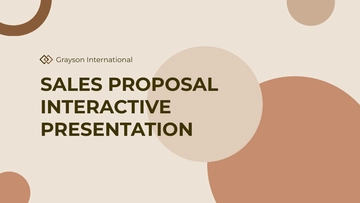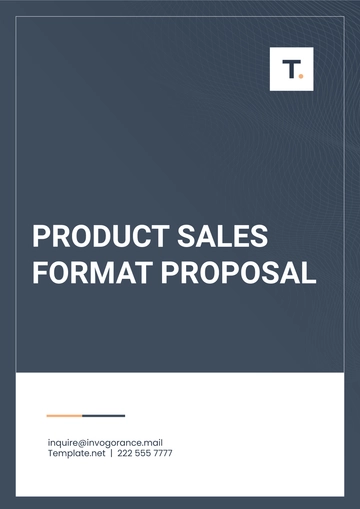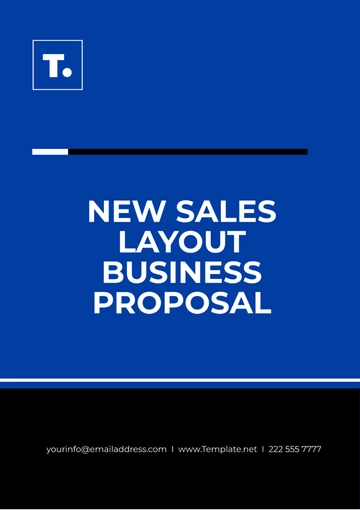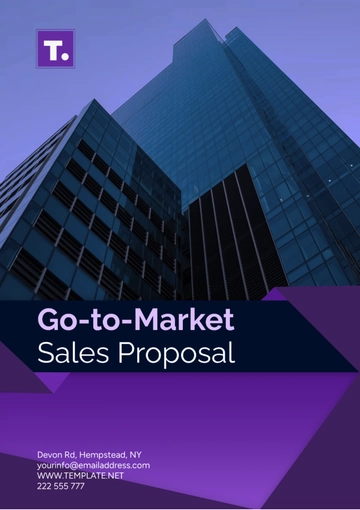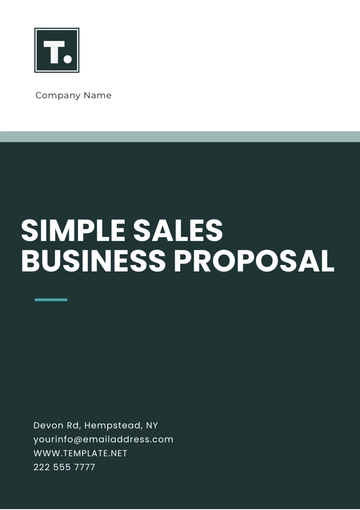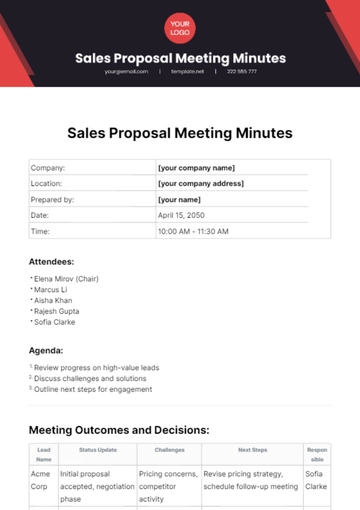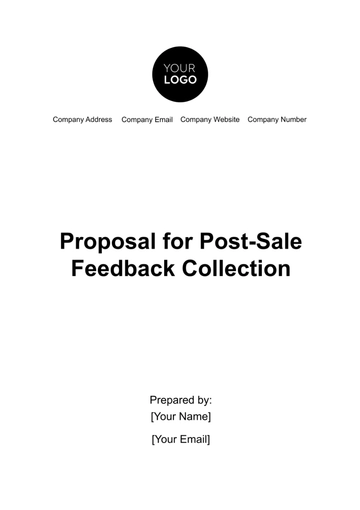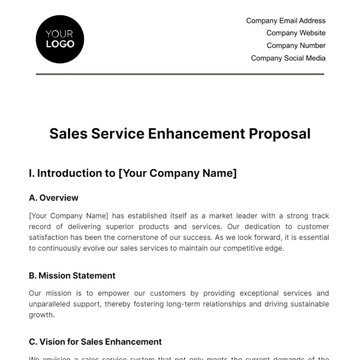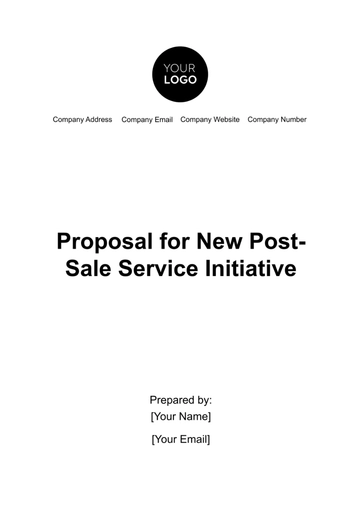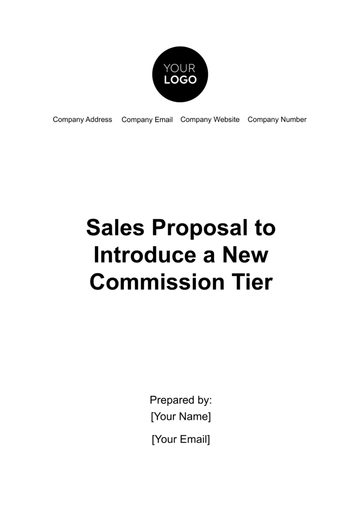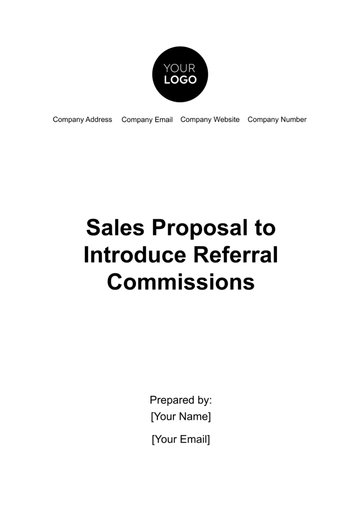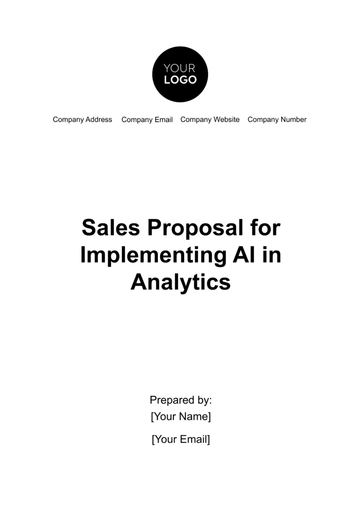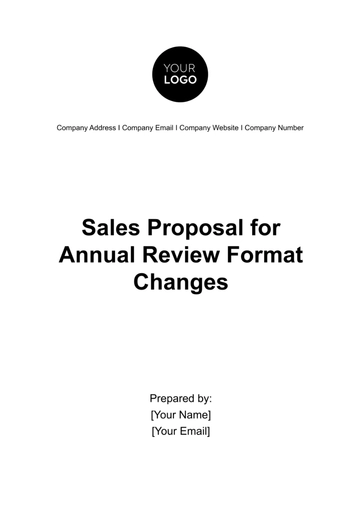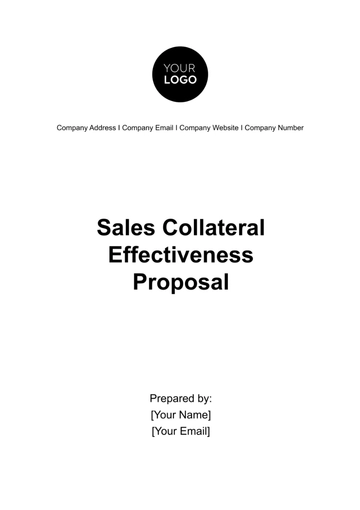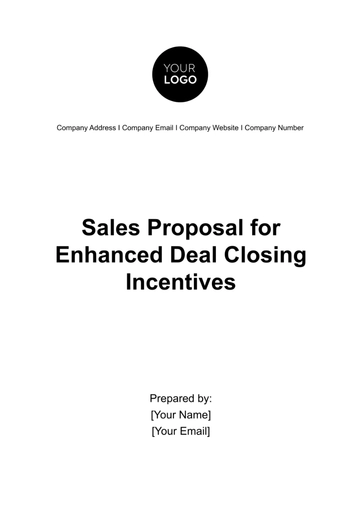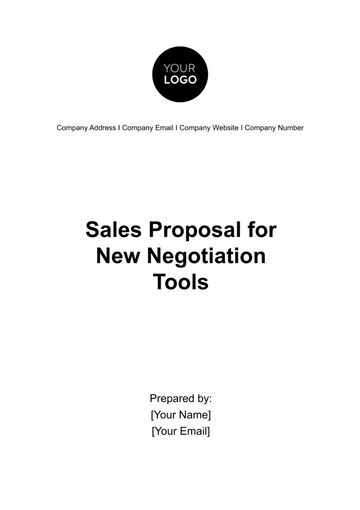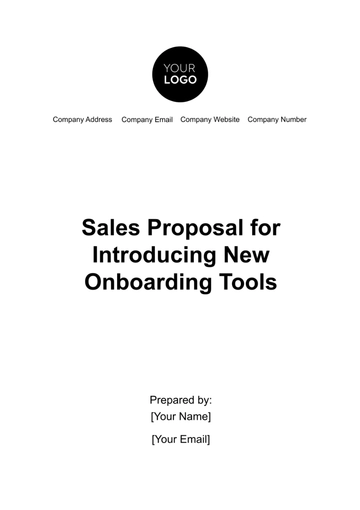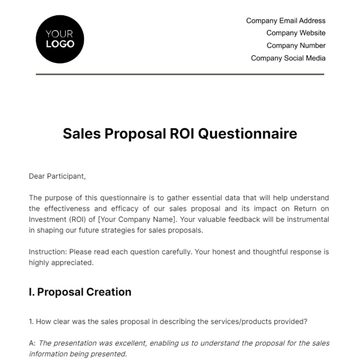Free Sales Strategic Proposal for Client Onboarding

Rationale
In today's competitive landscape, the initial experience of our clients significantly impacts their long-term satisfaction and loyalty. Recognizing this, we aim to enhance our client onboarding process, ensuring it not only meets but exceeds client expectations. This strategic focus is designed to solidify our relationships with new clients from the outset, setting a foundation for sustained engagement and growth. By addressing the current gaps and leveraging new opportunities, our revised onboarding strategy will play a pivotal role in our overall client management and satisfaction framework.
Current Onboarding Situation
Our current onboarding process has served us well in the past; however, as we scale and diversify our client base, several challenges and opportunities have emerged that necessitate a strategic overhaul:
Challenges:
Lack of Personalization: Our one-size-fits-all approach fails to address the specific needs and preferences of diverse client segments.
Inefficient Communication: Clients often experience delays in receiving crucial information, leading to frustration and a sense of neglect.
Limited Engagement Opportunities: New clients have few opportunities to interact with our team, leading to a slower integration into our ecosystem.
Opportunities:
Technology Integration: Leveraging new technologies can streamline the onboarding process, offering a more engaging and efficient client experience.
Feedback Mechanisms: Implementing structured feedback loops during onboarding can provide valuable insights for continuous improvement.
Customized Onboarding Paths: Developing tailored onboarding experiences can address the unique needs of different client segments, enhancing satisfaction.
Objectives of the Onboarding Strategy
Our revamped onboarding strategy aims to transform the initial client experience into a seamless, engaging, and personalized journey. The following objectives guide our strategic focus:
Enhance Client Satisfaction: Deliver an onboarding experience that exceeds client expectations, fostering a positive initial perception of our organization.
Increase Efficiency: Streamline the onboarding process to minimize delays and ensure clients can quickly utilize our services.
Improve Personalization: Offer customized onboarding paths that cater to the specific needs and preferences of various client segments.
Strengthen Communication: Establish clear, timely, and effective communication channels throughout the onboarding process.
Foster Engagement: Create meaningful opportunities for clients to engage with our team and resources, facilitating a deeper connection with our organization.
Collect and Utilize Feedback: Implement mechanisms to gather client feedback during onboarding, using this input to continuously refine and improve the onboarding experience.
Target Client Segment
Understanding the diversity of our client base is crucial to tailoring the onboarding experience effectively. Our clients come from a wide range of industries, each with distinct characteristics, expectations, and needs. By identifying and segmenting our target clients, we can create more personalized and impactful onboarding pathways. This segmentation allows us to address the specific challenges and leverage the unique opportunities within each segment, ensuring a more engaging and satisfactory onboarding experience.
Client Segment | Characteristics | Needs |
Small Businesses | Limited resources, seeking cost-effective solutions | Guidance on maximizing ROI, personalized attention |
Mid-Market Companies | Growing firms with evolving needs | Scalable solutions, strategic support |
Enterprise Clients | Large organizations with complex structures | Customization, comprehensive integration |
Onboarding Process Overview
Our onboarding process is designed to be comprehensive, engaging, and efficient, ensuring that clients feel supported and valued from the very beginning. By breaking down the process into distinct steps, we aim to create a seamless transition for clients into our ecosystem. Each step is crafted with the client's needs and preferences in mind, fostering a positive relationship and laying the groundwork for long-term engagement.
Initial Contact and Welcome: This first step involves reaching out to new clients with a personalized welcome message, outlining what they can expect from the onboarding process. It sets the tone for the entire relationship, emphasizing our commitment to their success.
Needs Assessment: We conduct a thorough assessment of the client's specific needs, goals, and challenges. This ensures that the onboarding process is tailored to deliver the most value to each client.
Account Setup and Customization: Based on the needs assessment, we guide clients through account setup and customization options. This step is crucial for ensuring that clients can begin deriving value from our services as quickly as possible.
Training and Resources: Clients receive access to training sessions and resources tailored to their segment. This education is critical for empowering clients to make the most of our services.
Feedback and Adjustment: We actively seek client feedback throughout the onboarding process, making adjustments as necessary to address any concerns or challenges that arise.
Integration and Follow-Up: The final step involves ensuring that the client is fully integrated into our ecosystem and conducting follow-up to confirm satisfaction and address any lingering questions.
Step | Timeline |
Initial Contact and Welcome | Day 1 |
Needs Assessment | Day 2-3 |
Account Setup and Customization | Day 4-5 |
Training and Resources | Day 6-10 |
Feedback and Adjustment | Ongoing |
Integration and Follow-Up | Day 30 |
Key Components of the Onboarding Strategy
Our onboarding strategy is composed of several key components, each designed to engage and support clients through their initial journey with our organization. From a warm welcome to personalized account setup and proactive engagement activities, we've crafted each element to ensure a seamless, informative, and enjoyable onboarding experience. By integrating these components into our strategy, we aim to build strong foundations for long-term client relationships, fostering satisfaction and loyalty from the outset.
1. Welcome Package
The Welcome Package serves as the first tangible touchpoint in our onboarding process, designed to make a positive and lasting impression. Contents include a personalized welcome letter from our CEO, an overview of our services and products, a guide to the onboarding process, and contact information for their dedicated account manager. Delivery methods are tailored to the client's preference, with options for digital delivery via email or a beautifully packaged physical delivery. This package not only conveys essential information but also demonstrates our commitment to client success and personal attention.
2. Initial Engagement Activities
To foster a strong initial engagement, we've developed a series of activities aimed at integrating clients into our ecosystem, educating them about our services, and building rapport between our team and the client. These activities are designed to be informative, interactive, and supportive, ensuring clients feel valued and connected.
Activity | Description |
Welcome Webinar | An interactive session introducing our team, services, and how we support our clients' success. |
Product Demonstration | A tailored demonstration highlighting features and benefits relevant to the client's needs. |
Q&A Sessions | Scheduled sessions to address any questions, ensuring clarity and confidence in our services. |
3. Account Setup and Customization
A critical step in the onboarding process is the account setup and customization, which ensures that the client's experience with our services is tailored to their specific needs and preferences. This step involves:
Collecting detailed information about the client's business, objectives, and requirements.
Clients specify their preferences for communication, reporting, and service delivery.
Based on the information and preferences gathered, we customize our services and products to align with the client's goals.
A final review with the client to confirm all settings and customizations, ensuring they are fully satisfied before moving forward.
4. Training and Support
An integral part of our onboarding strategy is providing comprehensive training and support to ensure clients can fully leverage our services and tools from day one. This approach is designed to empower clients, reducing the learning curve and fostering self-sufficiency while ensuring they know we're here to assist whenever needed. Our training programs are customized to match the client's technical ability and familiarity with our products, ensuring relevance and effectiveness.
Resource | Support System |
Interactive Tutorials | Step-by-step guides for using our services |
Live Training Sessions | Real-time instruction and Q&A opportunities |
Dedicated Support Line | 24/7 access to customer support for urgent queries |
Knowledge Base | An extensive library of articles and FAQs |
5. Feedback and Adjustment
Continuous improvement is at the heart of our onboarding process. We actively seek and incorporate client feedback to refine and enhance their experience. This commitment to responsiveness and adaptability ensures that our onboarding strategy remains client-centric and effective.
Surveys and Feedback Forms: Distributed at key points during the onboarding process to gather insights on the client's experience.
One-on-One Check-Ins: Scheduled meetings with the client to discuss their satisfaction and any adjustments needed.
Adjustment Implementation: A structured process for quickly implementing changes based on client feedback.
Roles and Responsibilities
The success of our onboarding process is a collective effort, involving various team members each playing a pivotal role. By clearly defining these roles, we ensure a coordinated and efficient onboarding experience for our clients.
Team Member | Role |
Account Manager | Primary client contact, oversees onboarding process |
Onboarding Specialist | Guides the client through setup and customization |
Training Coordinator | Organizes training sessions and resources |
Customer Support Agent | Provides ongoing support and addresses queries |
Success Metrics and Evaluation
Measuring the effectiveness of our onboarding process is crucial for continuous improvement. We've established clear metrics to evaluate our success and areas for enhancement.
Metric | Target Figure |
Client Satisfaction | 90% satisfaction rating |
Onboarding Duration | Less than 30 days |
Product Adoption Rate | 85% within the first 60 days |
Support Queries | 25% reduction in initial 30 days |
Following the collection of these metrics, we plan to conduct a comprehensive review every quarter. This review will involve analyzing the data, identifying trends, and pinpointing areas for improvement. Based on the findings, we will adjust our onboarding strategy to better meet our clients' needs and enhance their overall experience. This iterative process ensures that our onboarding remains effective, efficient, and aligned with our clients' evolving expectations.
Implementation Plan
The implementation of our onboarding strategy is meticulously planned to ensure a smooth and efficient process for both our team and our clients. This plan outlines the steps involved, their respective timelines, and the team members responsible for each task, ensuring accountability and clarity throughout the onboarding journey.
Step | Timeline | Responsibility |
Initial Contact and Welcome | 0-1 day | Account Manager |
Needs Assessment | 1-3 days | Onboarding Specialist |
Account Setup and Customization | 3-5 days | Onboarding Specialist |
Training and Resources | 5-10 days | Training Coordinator |
Feedback and Adjustment | Ongoing | Account Manager |
Integration and Follow-Up | 30 days | Account Manager |
Budget Allocation
A strategic budget allocation is critical for supporting the various components of our onboarding strategy. This budget covers the resources necessary for execution, including personnel, technology, and materials.
Component | Cost (USD) |
Welcome Packages | 5,000 |
Training Materials | 10,000 |
Technology and Software | 15,000 |
Personnel | 20,000 |
Miscellaneous | 5,000 |
Total | 55,000 |
The total budget for implementing our onboarding strategy is $55,000. The largest allocation goes towards personnel, reflecting the importance of human interaction and support in the onboarding process. Technology and software investments ensure our infrastructure can support a seamless, engaging client experience. The allocation for welcome packages and training materials directly contributes to client satisfaction and product adoption, crucial for long-term success.
Risk Management
Identifying potential risks and developing mitigation strategies are essential components of our implementation plan. This proactive approach ensures we are prepared to address challenges as they arise.
Risk | Likelihood | Impact | Mitigation |
Delay in Onboarding Process | Medium | High | Streamline processes, allocate additional resources |
Client Resistance to New Processes | Low | Medium | Offer comprehensive training and support |
Technical Issues | High | High | Regularly update and maintain technology platforms |
Budget Overruns | Low | Medium | Monitor expenses closely, adjust allocations as needed |
Conclusion
Our Sales Strategic Proposal for Client Onboarding outlines a comprehensive, client-centric approach designed to enhance the initial experience of our clients. Through a meticulously planned implementation process, strategic budget allocation, and proactive risk management, we aim to achieve our objectives of increased client satisfaction, efficiency, and personalization. By continuously evaluating and refining our strategy based on feedback and performance metrics, we ensure our onboarding process remains effective and aligned with our commitment to client success and satisfaction. This proposal represents not just a plan for onboarding but a strategic investment in the long-term relationships we build with our clients.
- 100% Customizable, free editor
- Access 1 Million+ Templates, photo’s & graphics
- Download or share as a template
- Click and replace photos, graphics, text, backgrounds
- Resize, crop, AI write & more
- Access advanced editor
Discover the Sales Strategic Proposal for Client Onboarding Template at Template.net, your key to unlocking successful client partnerships. This template is editable and customizable, allowing you to create a tailored onboarding proposal that resonates with your clients. Designed for flexibility and impact, editable in our AI Editor tool, it's your solution for a seamless client onboarding process.
You may also like
- Business Proposal
- Research Proposal
- Proposal Request
- Project Proposal
- Grant Proposal
- Photography Proposal
- Job Proposal
- Budget Proposal
- Marketing Proposal
- Branding Proposal
- Advertising Proposal
- Sales Proposal
- Startup Proposal
- Event Proposal
- Creative Proposal
- Restaurant Proposal
- Blank Proposal
- One Page Proposal
- Proposal Report
- IT Proposal
- Non Profit Proposal
- Training Proposal
- Construction Proposal
- School Proposal
- Cleaning Proposal
- Contract Proposal
- HR Proposal
- Travel Agency Proposal
- Small Business Proposal
- Investment Proposal
- Bid Proposal
- Retail Business Proposal
- Sponsorship Proposal
- Academic Proposal
- Partnership Proposal
- Work Proposal
- Agency Proposal
- University Proposal
- Accounting Proposal
- Real Estate Proposal
- Hotel Proposal
- Product Proposal
- Advertising Agency Proposal
- Development Proposal
- Loan Proposal
- Website Proposal
- Nursing Home Proposal
- Financial Proposal
- Salon Proposal
- Freelancer Proposal
- Funding Proposal
- Work from Home Proposal
- Company Proposal
- Consulting Proposal
- Educational Proposal
- Construction Bid Proposal
- Interior Design Proposal
- New Product Proposal
- Sports Proposal
- Corporate Proposal
- Food Proposal
- Property Proposal
- Maintenance Proposal
- Purchase Proposal
- Rental Proposal
- Recruitment Proposal
- Social Media Proposal
- Travel Proposal
- Trip Proposal
- Software Proposal
- Conference Proposal
- Graphic Design Proposal
- Law Firm Proposal
- Medical Proposal
- Music Proposal
- Pricing Proposal
- SEO Proposal
- Strategy Proposal
- Technical Proposal
- Coaching Proposal
- Ecommerce Proposal
- Fundraising Proposal
- Landscaping Proposal
- Charity Proposal
- Contractor Proposal
- Exhibition Proposal
- Art Proposal
- Mobile Proposal
- Equipment Proposal
- Student Proposal
- Engineering Proposal
- Business Proposal
